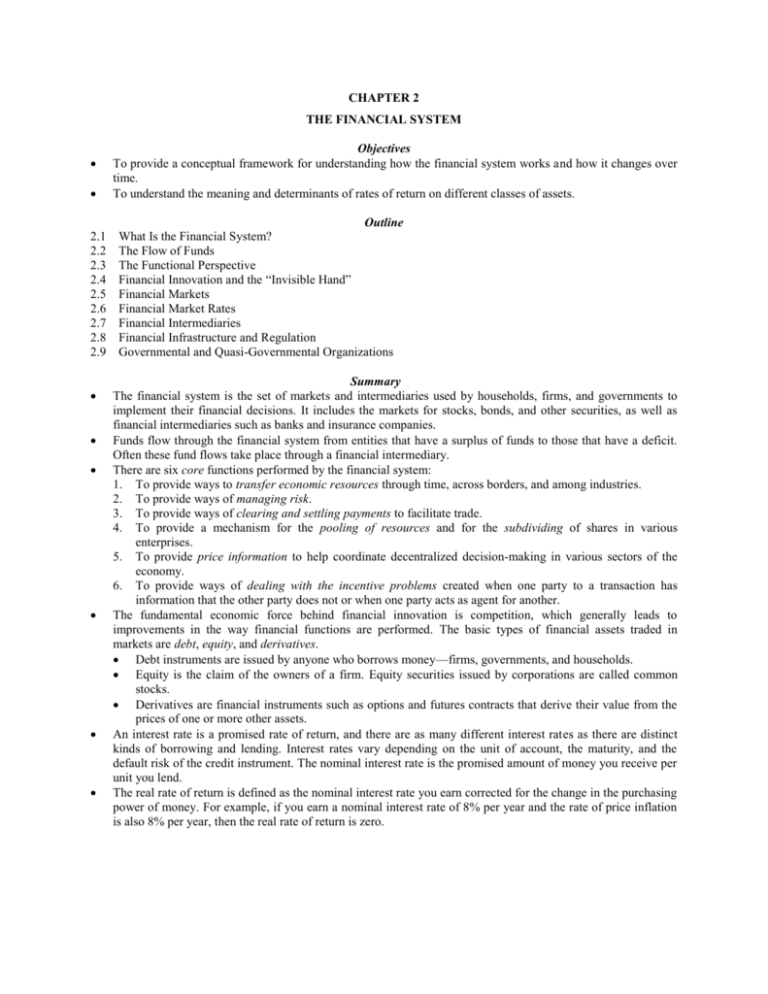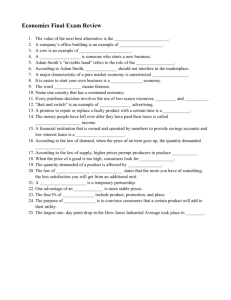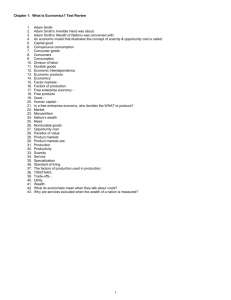No #2
advertisement

CHAPTER 2 THE FINANCIAL SYSTEM 2.1 2.2 2.3 2.4 2.5 2.6 2.7 2.8 2.9 Objectives To provide a conceptual framework for understanding how the financial system works and how it changes over time. To understand the meaning and determinants of rates of return on different classes of assets. Outline What Is the Financial System? The Flow of Funds The Functional Perspective Financial Innovation and the “Invisible Hand” Financial Markets Financial Market Rates Financial Intermediaries Financial Infrastructure and Regulation Governmental and Quasi-Governmental Organizations Summary The financial system is the set of markets and intermediaries used by households, firms, and governments to implement their financial decisions. It includes the markets for stocks, bonds, and other securities, as well as financial intermediaries such as banks and insurance companies. Funds flow through the financial system from entities that have a surplus of funds to those that have a deficit. Often these fund flows take place through a financial intermediary. There are six core functions performed by the financial system: 1. To provide ways to transfer economic resources through time, across borders, and among industries. 2. To provide ways of managing risk. 3. To provide ways of clearing and settling payments to facilitate trade. 4. To provide a mechanism for the pooling of resources and for the subdividing of shares in various enterprises. 5. To provide price information to help coordinate decentralized decision-making in various sectors of the economy. 6. To provide ways of dealing with the incentive problems created when one party to a transaction has information that the other party does not or when one party acts as agent for another. The fundamental economic force behind financial innovation is competition, which generally leads to improvements in the way financial functions are performed. The basic types of financial assets traded in markets are debt, equity, and derivatives. Debt instruments are issued by anyone who borrows money—firms, governments, and households. Equity is the claim of the owners of a firm. Equity securities issued by corporations are called common stocks. Derivatives are financial instruments such as options and futures contracts that derive their value from the prices of one or more other assets. An interest rate is a promised rate of return, and there are as many different interest rates as there are distinct kinds of borrowing and lending. Interest rates vary depending on the unit of account, the maturity, and the default risk of the credit instrument. The nominal interest rate is the promised amount of money you receive per unit you lend. The real rate of return is defined as the nominal interest rate you earn corrected for the change in the purchasing power of money. For example, if you earn a nominal interest rate of 8% per year and the rate of price inflation is also 8% per year, then the real rate of return is zero. Finance Instructor’s Manual Chapter 2 Page 24 There are four main factors that determine rates of return in a market economy: the productivity of capital goods—expected rates of return on mines, dams, roads, bridges, factories, machinery, and inventories, the degree of uncertainty regarding the productivity of capital goods, time preferences of people—the preference of people for consumption now versus consumption in the future, and risk aversion—the amount people are willing to give up in order to reduce their exposure to risk. Indexing is an investment strategy that seeks to match the returns of a specified stock market index. Financial intermediaries are firms whose primary business is to provide customers with financial products that cannot be obtained more efficiently by transacting directly in securities markets. Among the main types of intermediaries are banks, investment companies, and insurance companies. Their products include checking accounts, loans, mortgages, mutual funds, and a wide range of insurance contracts. Finance Instructor’s Manual Chapter 2 Page 25 Solutions to Problems at End of Chapter 1. Do you agree with Adam Smith’s view that society can rely more on the “invisible hand” than on government to promote economic prosperity? Student answers will vary of course. SAMPLE ANSWER: The communist system is the exact opposite of Adam Smith’s invisible hand. And of course we have recently seen the downfall of many of the communist countries around the world. In the communist world, it was believed that government could make better decisions promoting economic prosperity than individuals could. Clearly this system failed to promote economic prosperity. It seems that Adam Smith’s view was that competitive market systems as a whole (rather than government) could best allocate resources to promote economic prosperity. However, a completely unfettered capitalist society such as in the late 1800s in the Western world may not have been the perfect system either as the invisible hand helped the “rich get richer” while the poor and needy had no formal assistance. This outraged the moral fabric of society and government programs were eventually set up to formally address this issue of general welfare and “fairness”. 2. How does the financial system contribute to economic security and prosperity in a capitalist society? In a capitalist society, it is the price system which helps make capital resource decisions. Capital flows to those operations which can employ it to earn the highest rate of return. This therefore allocates capital to its most productive use, thereby enhancing society’s economic prosperity. In addition, the financial system has markets and intermediaries which transfer risks from those who are least willing to bear it to those who are most willing to bear it. This benefits society as a whole without costing it anything. In addition, by allowing individuals to reduce or eliminate risks, it fosters an atmosphere of undertaking business ventures which also benefits society. 3. Give an example of how each of the six functions of the financial system are performed more efficiently today than they were in the time of Adam Smith (1776). Clearing and settling payments: In Adam Smith’s day, just as today there was paper and coin currency. However, due to technological innovations (primarily the computer) today there are many additional forms of payment settlement such as personal checks, credit cards, debit cards and electronic transfer of funds. In addition, certain credit cards and traveler’s checks are accepted everywhere in the world making currency exchange a relic of the past. Pooling resources and subdividing shares: In Adam Smith’s day, most businesses were small and were financed by sole proprietorships. Therefore the need to pool resources to finance large investments was not as prevalent or as important as it is today. Again, the technological revolution of computers and telephones allow for global capital markets to efficiently finance today’s much larger businesses. Today these companies can access huge pools of money around the world and find the cheapest source of financing for large scale projects. Transfer economic resources: Today there is a worldwide financial system which facilitates the transfer of resources and risk from one individual to another and from one point in time to another. In Adam Smith’s day, although there were financial markets which played a limited role, they were localized, small and much less efficient and innovative than they are today. Managing risk: Of course during Adam Smith’s day individuals and businesses faced many of the same risks they do today (risk of property damage, risk of financial loss, risk of crop failure etc.) However, there were limited means to offset this risk. There were some insurance companies in place at that time, however, they concentrated on managing business risk rather than personal risk and certainly there was not the same type of insurance. A good example is that in Adam Smith’s day, there was no unemployment insurance. In Adam Smith’s day, there was very little a farmer could do about reducing his risk of crop failure or lower crop prices. Today there are a vast number of markets and securities which can be used to offset individual and business risk as well as a huge network of insurance companies whose role is to transfer risk from those who want to reduce risk to those who want to take on more risk. Finance Instructor’s Manual Chapter 2 Page 26 Price information: During Adam Smith’s day, information traveled slowly. Of course, there were no phones, televisions or radios. News traveled by newspaper and by the mail. Today, information travels around the world instantaneously. Due primarily to the growth and innovation in computer and telephone technology, information about security prices and performance is known at virtually the same time everywhere around the world. Incentive problems: As discussed above, today’s financial system is large, innovative and global. In Adam Smith’s day, while there were problems of moral hazard and adverse selection (but less of a principal-agent problem) there was not the same financial system and sophistication to deal with these problems as there is today. 4. How does a competitive stock market accomplish the result that Adam Smith describes? Should the stock market be regulated? How and why? Student answers will vary. SAMPLE ANSWER: Adam Smith talked about free and competitive markets as a system which allocates capital to its most productive use and greatest value. In a competitive stock market, prices are set through supply and demand. Those companies returning the highest return will be rewarded with the highest prices (or cheapest source of financing). Those companies which are under performing will not be allocated as much capital because they are not as productive. Because the universe of possible investments is huge and because it is at times difficult for investors to discern which companies are the most productive employers of capital, regulation should be required to make sure relevant and standardized information is disseminated to potential investors. This would include regulation on disclosure and also insider trading and stock manipulation. However other forms of market regulation are perhaps not so important from a market efficiency point of view and may even impede society’s overall financial welfare. 5. Would you be able to get a student loan without someone else offering to guarantee it? Since most students do not have any earning power (yet) or source of savings or other capital, it is doubtful any intermediary would take that credit risk at any reasonable interest rate. 6. Give an example of a new business that would not be able to get financing if insurance against risk were not available. EXAMPLES: Chemical company Child safety products company Airline Bank Hospital Environmental consulting Hazardous waste disposal 7. Suppose you invest in a real-estate development deal. The total investment is $100,000. You invest $20,000 of your own money and borrow the other $80,000 from the bank. Who bears the risk of this venture and why? The $20,000 of my own money is considered the equity capital and the $80,000 is debt financing. In general it is the equity investors who absorb the primary risk of business failure. This is because if the business goes bankrupt, I will unlikely get any or my money back as the debt holders get paid back before I do. However, the debt holder also faces some risk that it will not even get back all its principal and interest. So lenders do share some of the business risk along with the equity investors. Finance Instructor’s Manual Chapter 2 Page 27 8. You are living in the United States and are thinking of traveling to Germany 6 months from now. You can purchase an option to buy marks now at a fixed rate of $0.75 per mark 6 months from now. How is the option like an insurance policy? An option means you have a choice. In this example you can choose to buy the marks at $0.75 in 6 months but you do not have to. You will only buy the marks at this price if it is cheaper for you to do so (if the spot market at that time is higher). Therefore, like an insurance policy you are protected against a potential loss. You know that the maximum price you will have to pay is $0.75 per mark and that you are protected against any higher price. Presumably you will have to pay something for the price of that option and that can be equated to an insurance premium. 9. Give an example of how the problem of moral hazard might prevent you from getting financing for something you want to do. Can you think of a way of overcoming this problem? SAMPLE ANSWER: Suppose I want to start a biotechnology business and I need a lot of financing. The trouble is, I do not want to disclose my technology secrets to potential equity and debt investors. I will have great difficulty raising financing. But I could do the following: At a minimum, I could require all potential lenders and investors to sign agreements saying they will not disclose any of my secrets. Secondly, I could share some of my equity with potential lenders (equity-kickers) and investors (stock and stock options). At least that way they will not be motivated to disclose my secrets to others. Finally, if I decided I did not want to share secrets, I could give collateral in my new plant to the debt lenders and that might make them more comfortable with the issue of moral hazard. 10. Give an example of how the problem of adverse selection might prevent you from getting financing for something you want to do. Can you think of a way of overcoming this problem? SAMPLE ANSWER: Suppose I want to start a car leasing business. Initially my plan was to purchase several automobiles and lease them out at attractive annual rates. However, potential lenders were worried that my business would attract individuals who drive great distances each year. Rather than buy their own car and lose significant value, they would lease my cars and take a new one each year. I would not be able to obtain financing for this business until I instituted annual mileage restrictions. This alteration in the business plan was enough to make the lenders comfortable with the potential problem of adverse selection. 11. Give an example of how the principal-agent problem might prevent you from getting financing for something you want to do. Can you think of a way of overcoming this problem? SAMPLE ANSWER: Suppose you want to start a personal care products company. However, you have the idea for the business, but you do not want to actually run the business. To do that you have hired an executive from a competitor. He will own no equity in the business but will be paid a salary of $100,000 to start up the business. Trouble with this example is that the executive you have hired has little incentive to make the business really work other than his salary (which presumably he could earn at many different companies). What if this executive is really a spy? It may be difficult to get financing for this venture. The way to solve the problem is if you the owner decide to run the business (you certainly are motivated for it do well) or at a minimum, grant your new employee stock or stock options in the business. 12. Why is it that a country’s postage stamps are not as good a medium of exchange as its paper currency? Postage stamps would be much easier to copy (to counterfeit) than paper currency which has intricate designs and is made of special fibers (not easily duplicated). Secondly, postage stamps would not be as durable as paper currency and because of their other use, could easily stick to other items! Finally, because postage stamps are used for another purpose, one might run out of them and have to make a special trip to the post office to get more. Of course, the post office is not as convenient as an ATM machine for getting a new supply of currency. 13. Who is hurt if I issue counterfeit U.S. dollars and use them to purchase valuable goods and services? If this were done in great size, everyone would be hurt through the inflation that would result in the increased money supply. However, if done in a small amount, the individuals accepting the currency are taking on the risk (without knowing it) that the dollars will not be accepted by others as a medium of exchange. Finance Instructor’s Manual Chapter 2 Page 28 14. Some say the only criterion to use in predicting what will serve as money in the future is the real resource cost of producing it, including the transaction costs of verifying its authenticity. According to this criterion what do you think will be the money of the future? SAMPLE ANSWER: Payments via electronic transfer may become the medium of choice. It is a very cheap way to create currency. The biggest challenge will be to create security systems that do not allow for tampering and fraud. Once this is done and once most individuals and retail establishments have access to the system (through bank accounts and linking computer systems) then this should become the “currency” of choice. 15. Should all governments issue debt that is indexed to their domestic price level? Is there a moral hazard problem that citizens face with regard to their public officials when government debt is fixed in units of the domestic currency? The answer is that all governments should issue debt that is indexed to their domestic price level. This is due to the fact that if debts are not indexed to the domestic price level, governments have the incentive to print money to repay those debts, thereby increasing domestic inflation which negatively impacts all of society. 16. Describe your country’s system for financing higher education. What are the roles played by households, voluntary non-profit organizations, businesses and government? SAMPLE ANSWER: In the United States, the vast majority of higher education is paid for by individuals through savings. These sums can be supplemented in whole or in part by government-guaranteed loans and through student loans and scholarships provided by universities themselves as well as by private foundations such as those provided by the Fulbright scholarship. 17. Describe your country’s system for financing residential housing. What are the roles played by households, businesses and government? SAMPLE ANSWER: In the United States individuals and individual borrowings from savings and loans, commercial banks and mortgage lending companies finance the vast majority of residential housing through individual equity savings. The government guarantees a certain amount of low income mortgages and local governments finance some low-income housing. Businesses play a role through the lending business as well as through the financial markets which provide liquidity for portfolios of certain standardized mortgages. 18. Describe your country’s system for financing new enterprises. What are the roles played by households, businesses and government? SAMPLE ANSWER: In the United States, the vast majority of new enterprises is financed through individual savings and through initial public offerings made to the general public. These sources of financing are augmented by established firms which spend research and development (R&D) dollars developing new products and businesses and by venture capital institutions which also provide start-up financing. 19. Describe your country’s system for financing medical research. What are the roles played by voluntary non-profit organizations, businesses and government? SAMPLE ANSWER: In the United States, medical research is financed both by non-profit organizations (such as universities and medical facilities as well as organizations such as the American Heart Association) as well as by businesses such as Merck, Johnson & Johnson and Genentech. The government is involved in research grants, primarily to universities. Finance Instructor’s Manual Chapter 2 Page 29 20. Assume there are only two stocks traded in the stock market, and you are trying to construct an index to show what has happened to stock prices. Let us say that in the base year the prices were $20 per share for stock 1 with 100 million shares outstanding and $10 for stock 2 with 50 million shares outstanding. A year later, the prices are $30 per share for stock 1 and $2 per share for stock 2. Using the two different methods explained in the chapter, compute stock indexes showing what has happened to the overall stock market. Which of the two methods do you prefer and why? (See appendix that follows.) DJI-Type Index = Average of Current Prices/Average of Base Prices * 100 = 106.67 S&P-Type Index = (Weight of Stock 1 * Current Price of Stock 1 / Base Price of Stock 1 + Weight of Stock 2 * Current Price of Stock 2/Base Price of Stock 2) * 100 = 124 The S&P-Type Index accurately reflects what has happened to the total market value of all stocks. Finance Instructor’s Manual Chapter 2 Page 30








